Huawei Technologies G7010 GSM Mobile Phone User Manual
Huawei Technologies Co.,Ltd GSM Mobile Phone
User Manual
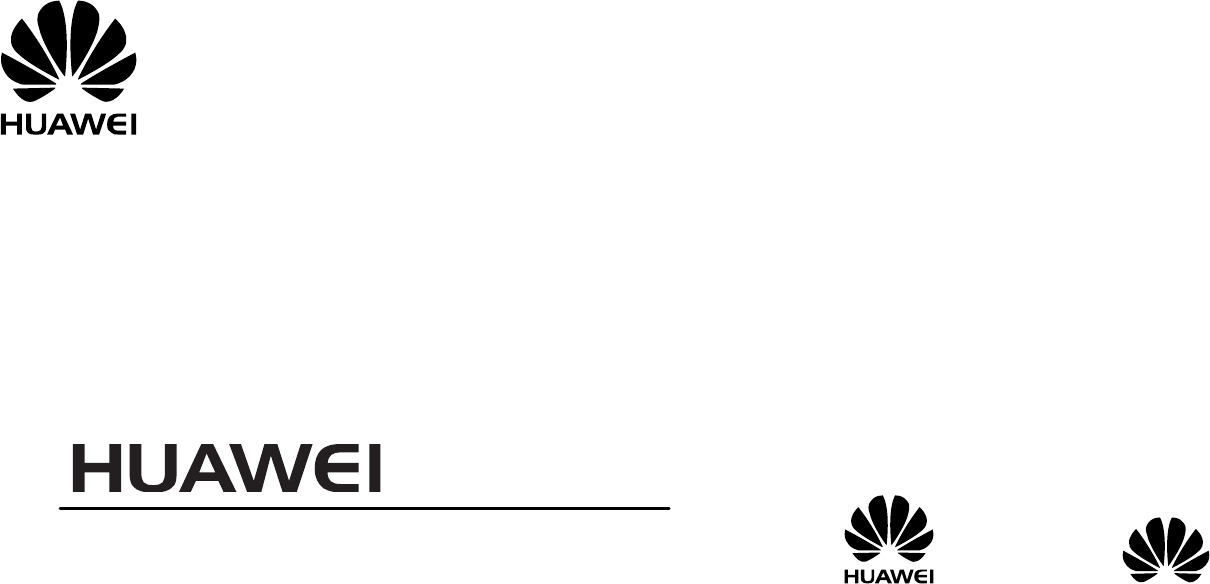
G7010
GSM Mobile Phone
User Guide
Copyright © Huawei Technologies Co., Ltd. 2010. All
rights reserved.
No part of this document may be reproduced or transmitted in
any form or by any means without prior written consent of
Huawei Technologies Co., Ltd.
The product described in this manual may include copyrighted
software of Huawei Technologies Co., Ltd. and possible licensors.
Customers shall not in any manner reproduce, distribute, modify,
decompile, disassemble, decrypt, extract, reverse engineer,
lease, assign, or sublicense the said software, unless such
restrictions are prohibited by applicable laws or such actions are
approved by respective copyright holders under licenses.
Trademarks and Permissions
, HUAWEI, and are trademarks or registered
trademarks of Huawei Technologies Co., Ltd.
Other trademarks, products, services, and company names
mentioned are the property of their respective owners.
Notice
Some features of the product and its accessories described
herein rely on the software installed, capacities and settings of
the local network, and may not be activated or may be limited
by local network operators or network service providers. Thus,
the descriptions herein may not exactly match the product or its
accessories you purchase.
Huawei Technologies Co., Ltd. reserves the right to change or
modify any information or specifications contained in this
manual without prior notice or obligation.
NO WARRANTY
THE CONTENTS OF THIS MANUAL ARE PROVIDED “AS IS”.
EXCEPT AS REQUIRED BY APPLICABLE LAWS, NO
WARRANTIES OF ANY KIND, EITHER EXPRESS OR IMPLIED,
INCLUDING BUT NOT LIMITED TO, THE IMPLIED WARRANTIES
OF MERCHANTABILITY AND FITNESS FOR A PARTICULAR
PURPOSE, ARE MADE IN RELATION TO THE ACCURACY,
RELIABILITY OR CONTENTS OF THIS MANUAL.
TO THE MAXIMUM EXTENT PERMITTED BY APPLICABLE LAW,
IN NO CASE SHALL HUAWEI TECHNOLOGIES CO., LTD BE
LIABLE FOR ANY SPECIAL, INCIDENTAL, INDIRECT, OR
CONSEQUENTIAL DAMAGES, OR LOST PROFITS, BUSINESS,
REVENUE, DATA, GOODWILL OR ANTICIPATED SAVINGS.
Import and Export Regulations
Customers shall comply with all applicable export or import laws
and regulations and will obtain all necessary governmental
permits and licenses in order to export, re-export or import the
product mentioned in this manual including the software and
technical data therein.
i
Contents
1 Introduction ..............................................................1
SIM Card...................................................................1
microSD Card............................................................2
Your Phone ............................................................... 4
Keys and Functions.................................................... 5
Touch Screen ............................................................ 5
Calibrating the Screen................................................ 6
Home Screen.............................................................6
2 Getting Started..........................................................8
Powering On or Off the Phone .................................... 8
Phone Password ........................................................ 8
PIN and PUK ............................................................. 9
Locking the Screen and the Keypad.............................9
Applications............................................................... 9
3 Voice Services..........................................................11
On-screen Numeric Keypad ...................................... 11
Making a Call........................................................... 12
Answering a Call...................................................... 13
Options During the Call ............................................ 13
4 Text Entry................................................................14
Text Entry Screen .................................................... 14
Enter Letters........................................................... 15
Enter Numbers and Symbols..................................... 15
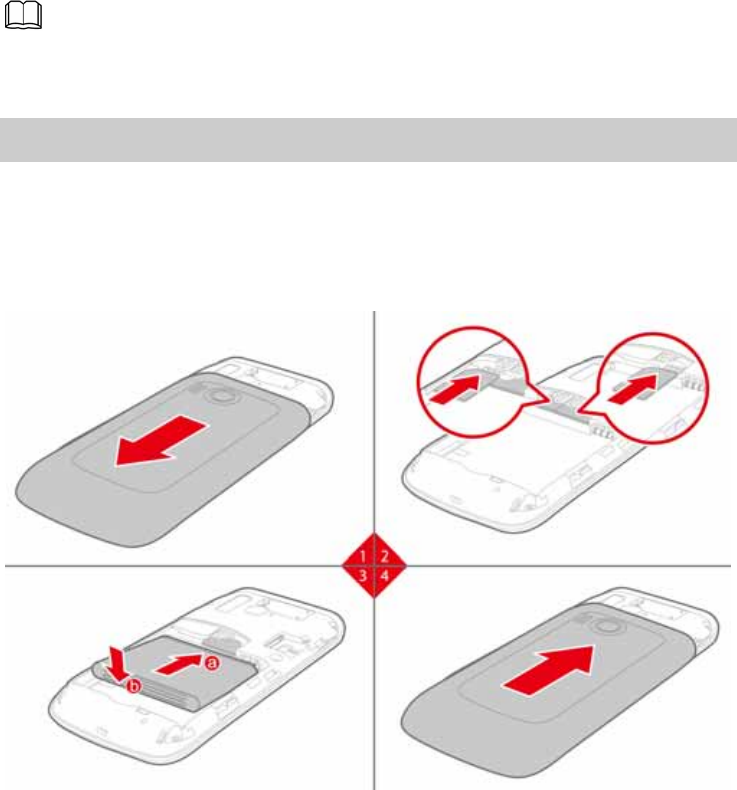
ii
5 Messaging................................................................17
6 Contacts...................................................................19
7 Camera ....................................................................21
Taking a Picture....................................................... 21
Recording a Video Clip ............................................. 22
8 Media Player............................................................23
Creating a New Playlist............................................. 23
Playing a Media File................................................. 23
Media Player ........................................................... 24
9 FM Radio..................................................................26
FM Radio ................................................................ 26
Tuning.................................................................... 27
10 WAP.......................................................................27
Setting the Connection Profile................................... 28
Connecting to the Network....................................... 28
11 Connectivity...........................................................29
USB........................................................................ 29
Bluetooth................................................................ 29
12 Warnings and Precautions.....................................31
1
1 Introduction
All the images in this guide are provided only for your
reference. The actual appearance and display depends on
the phone that has been delivered.
SIM Card
Insert your SIM card before using your phone. Remove the SIM
card and the battery only after powering off your phone.
The following figures show the process of inserting the SIM
card.
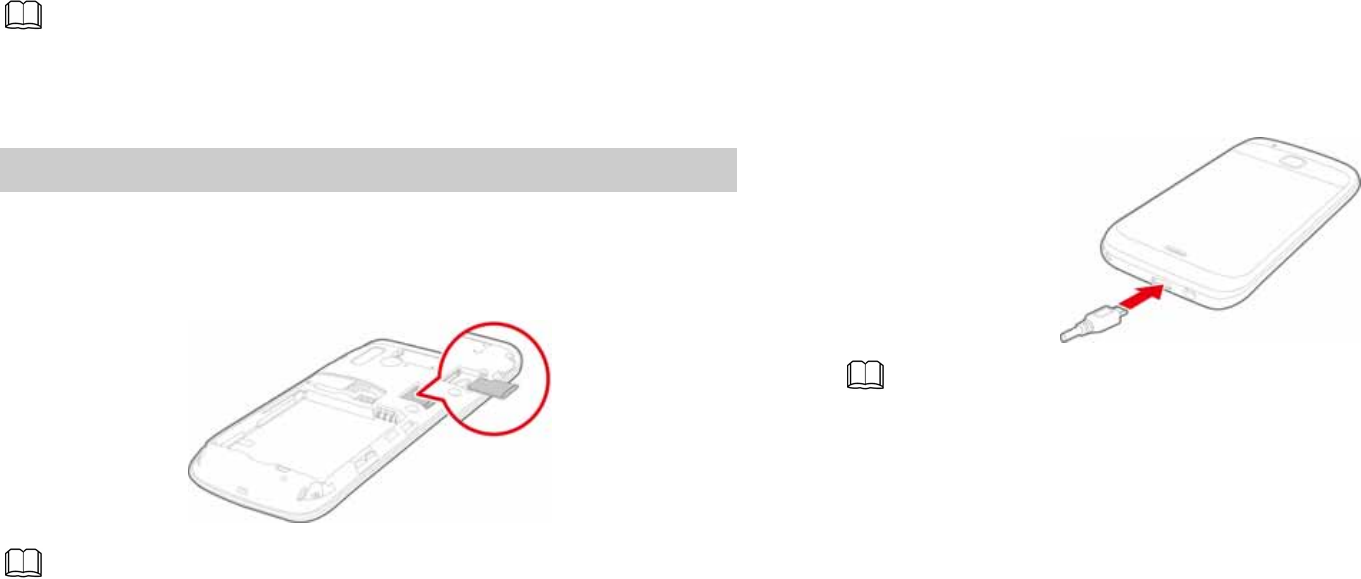
2
If your phone supports two SIM cards, you can insert two
SIM cards into the phone at one time, and select Menu >
Settings > Dual SIM settings > Dual SIM open to
enable the dual-SIM mode.
microSD Card
Your phone supports a microSD card with a capacity of up to 4
GB.
The following figure shows the insertion of the microSD card.
The microSD card is optional. You may not find a microSD
card in the package. If a microSD card is required, you can
buy one.
3
Charging the Battery
You can use the lithium battery of the mobile phone
immediately after unpacking. A new battery performs best after
it is fully charged and discharged three times.
z During the charging process, the charging icon is in an
animated state. When all bars of the charging icon are
displayed and the icon becomes static, it indicates that
the battery is fully charged.
z When you charge a completely exhausted battery, the
charging icon may appear several minutes later.
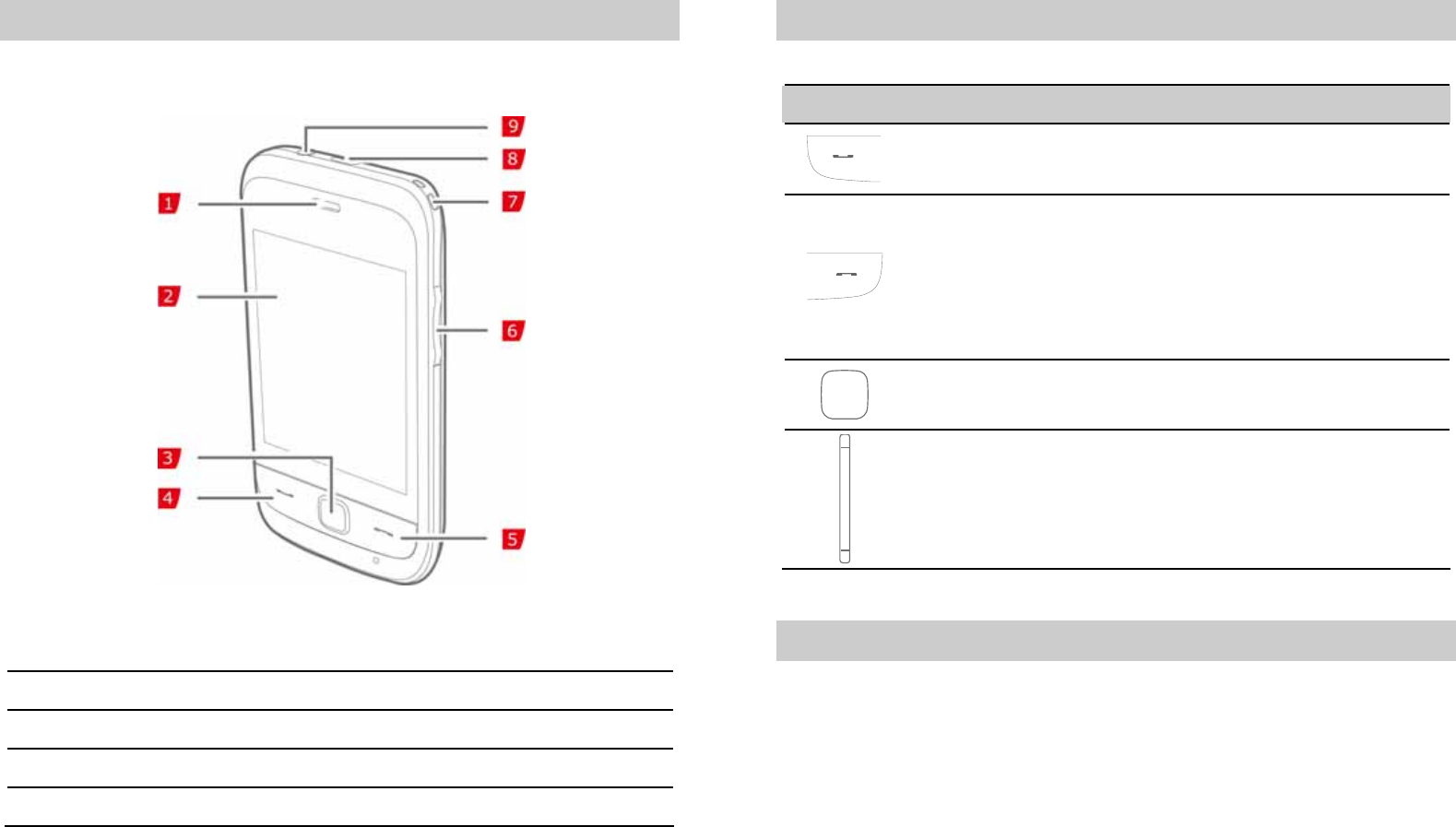
4
Your Phone
The following figure shows the appearance of your phone and it
is provided only for your reference.
1 Earpiece 2 Screen
3 Confirm key 4 Call/Answer key
5 End/Power key 6 Volume/Scroll key
7 Hand-strap hole 8 Charger/USB interface
9 Headset jack
5
Keys and Functions
Press… To…
z Make a call, or answer an incoming call.
z View call logs in standby mode.
z Power on or power off the phone (by pressing
and holding it for about three seconds).
z End a call, or reject an incoming call.
z Lock keys and the screen in standby mode.
z Return to the standby mode.
z Display the main menu in standby mode.
z Confirm a selection.
z Adjust the volume in standby mode, during a
call, or when playing music or videos.
z Scroll up and down a menu.
Touch Screen
You can tap the touch screen to select an item or enter text.
z Tap
Touch the screen once to select an item or access a menu.
Tap the icon accurately to select an item, and tap gently to
protect your touch screen.
z Slide
Tap the screen, and then move the finger or stylus to scroll
menus or pages.
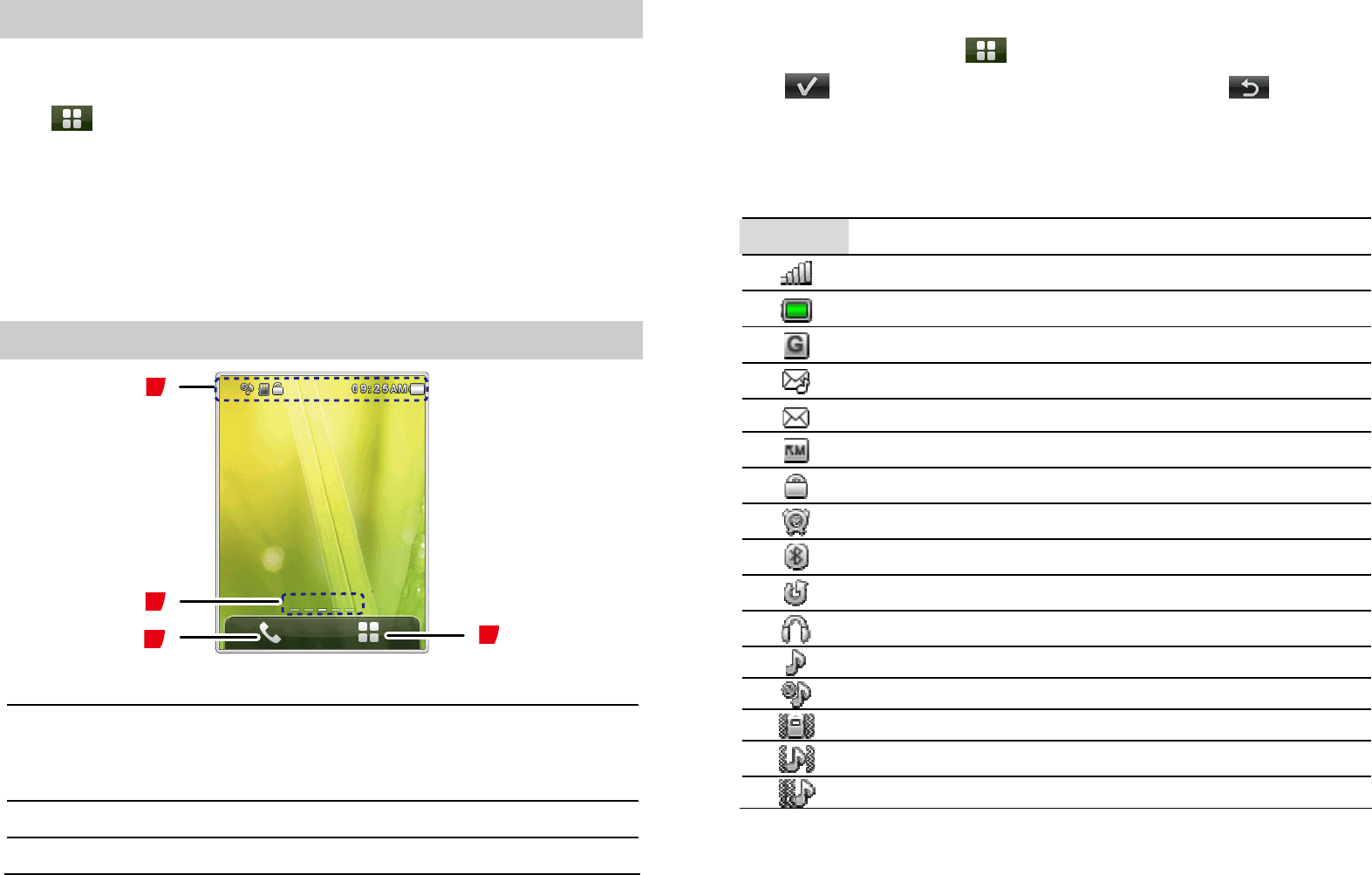
6
Calibrating the Screen
The phone can respond to the touch on the screen accurately
after screen calibration.
Tap in standby mode, and then select Settings > Pen
calibration. Tap the cross marks that appear on the screen in
sequence according to the prompts that are displayed to
complete adjusting the phone display.
When calibrating the screen, tap the cross marks exactly. Then
you can get the precision of responses to taps and handwriting
input.
Home Screen
2
1
4
3
1 Icons
2 Widgets
Slider on the screen to switch between widgets in standby
mode.
3 To display the call screen.
4 To display the function menu.
7
Using the Function Menu
In standby mode, tap to display function menus.
Tap to display the selected menu, and tap to return
to the previous menu.
Icons
The following table includes most of the commonly used icons.
Icon Indicates
Signal strength
Battery power level
GPRS
New multimedia message (MMS)
New text message (SMS)
The phone is in roaming state.
The screen and the keypad are locked.
An alarm is enabled.
The Bluetooth is enabled.
Call forwarding is enabled.
The earphone is plugged in.
The alert type is Ring only.
The alert type is Silence.
The alert type is Vib. only.
The alert type is Vib. and ring.
The alert type is Vib. then ring.
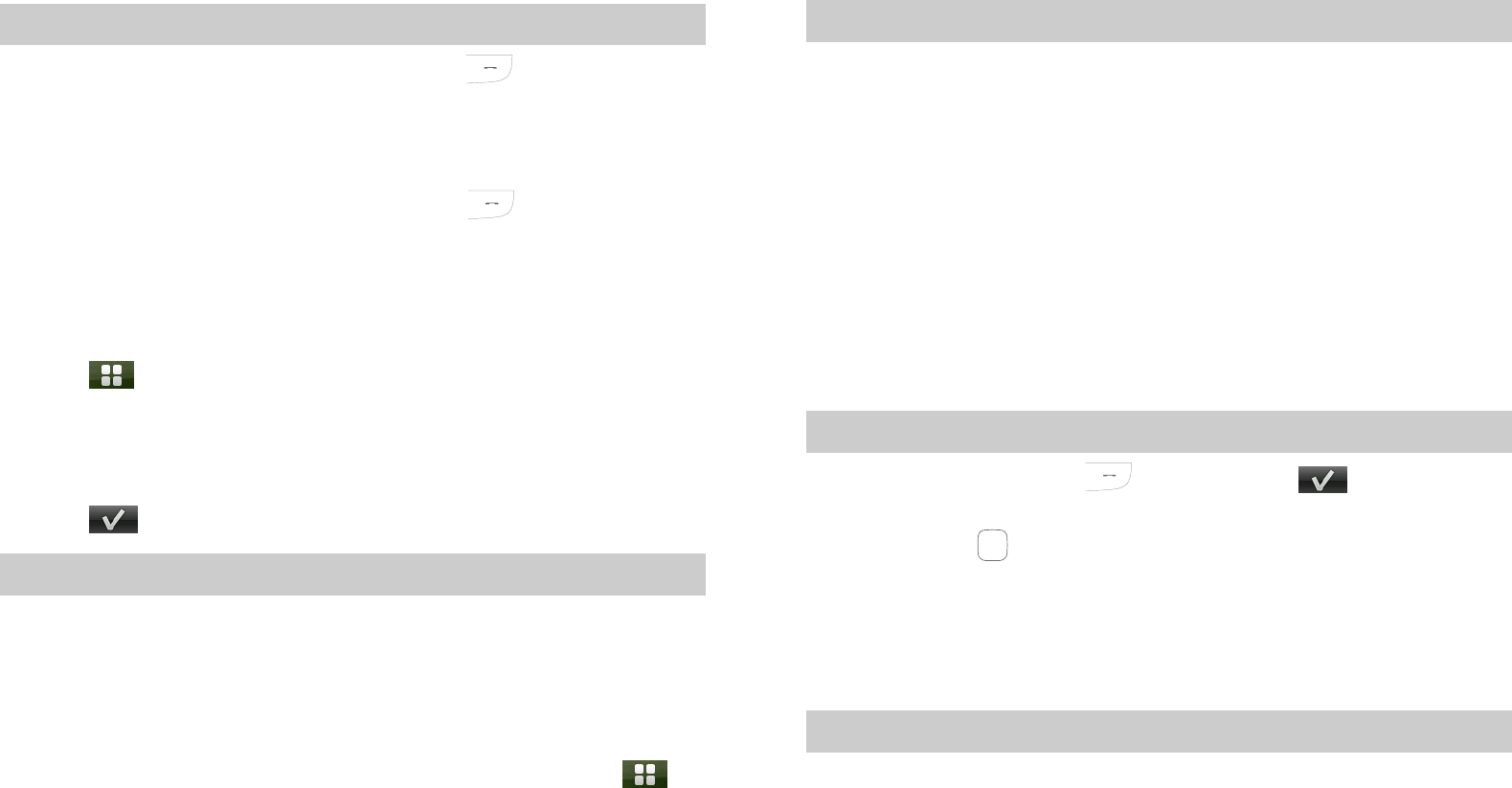
8
2 Getting Started
Powering On or Off the Phone
To switch on your phone, press and hold for about three
seconds. If a prompt is displayed, enter your phone password or
personal identification number (PIN). The PIN is delivered with
the SIM card.
To switch off your phone, press and hold for about three
seconds.
You can also do as follows to schedule powering on or off the
phone automatically. The phone will automatically power on or
off according to your settings.
1. Tap in standby mode, and then select Settings >
Phone settings > Schedule power on/off.
2. Select one timer.
3. Set the status and the time.
4. Tap to save the settings.
Phone Password
The phone code is used to protect your phone from
unauthorized use and restore factory settings. If the phone lock
function is enabled, you need to enter the phone code every
time you power the phone on. By default, the phone lock
function is disabled.
The phone code is set to 1234 by default. You can tap in
standby mode, and then select Settings > Security settings
9
> Change password > Phone password to change the
phone code into any numeric string of four to eight digits.
Do remember your phone code. If you forget the phone code,
contact the service center.
PIN and PUK
The personal identification number (PIN) protects your SIM
card from unauthorized use. The PIN unblocking key (PUK) can
unlock the blocked PIN. Both the PIN and the PUK are provided
with the SIM card. For details, contact your service provider.
If you enter wrong PINs for a specified number of times
consecutively, the phone displays a prompt asking you to enter
the PUK.
If you enter wrong PUKs for a specified number of times
consecutively, the SIM card becomes invalid permanently. In
this case, you need to contact your service provider for a new
SIM card.
Locking the Screen and the Keypad
In standby mode, press and then tap to lock the
keypad and screen. To activate the screen and unlock the
keypad, press and then touch the screen according to the
prompt that is displayed.
If the Auto keypad lock function is enabled and if the phone is
in standby mode for a preset period, the keypad is locked
automatically.
Applications
z Calculator: to perform simple calculations.
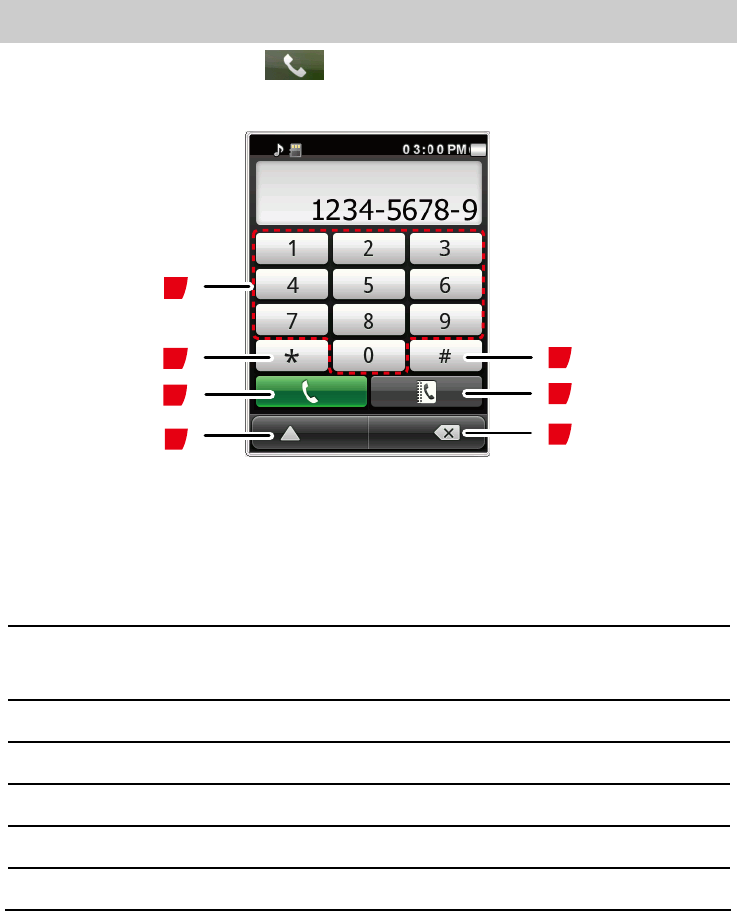
10
z Calendar: to view dates and set events.
z Task: to view and set tasks.
z World clock: to view and set the world clock.
z Alarm: to set alarms.
z Java: to download and install java applications and games.
11
3 Voice Services
On-screen Numeric Keypad
In standby mode, tap to access the on-screen numeric
keypad.
1
2
7
45
6
3
1 Number keys.
z To enter phone numbers.
z To call the voicemail by tapping and holding the 1 key for
about three seconds.
2 * key: to enter * by tapping it once, + by tapping it twice,
P by tapping it three times, or W by tapping it four times.
3 To call the phone number.
4 To display the options.
5 To clear the number or symbol on the left of the cursor.
6 To display the contacts.
7 # key: to enter #.
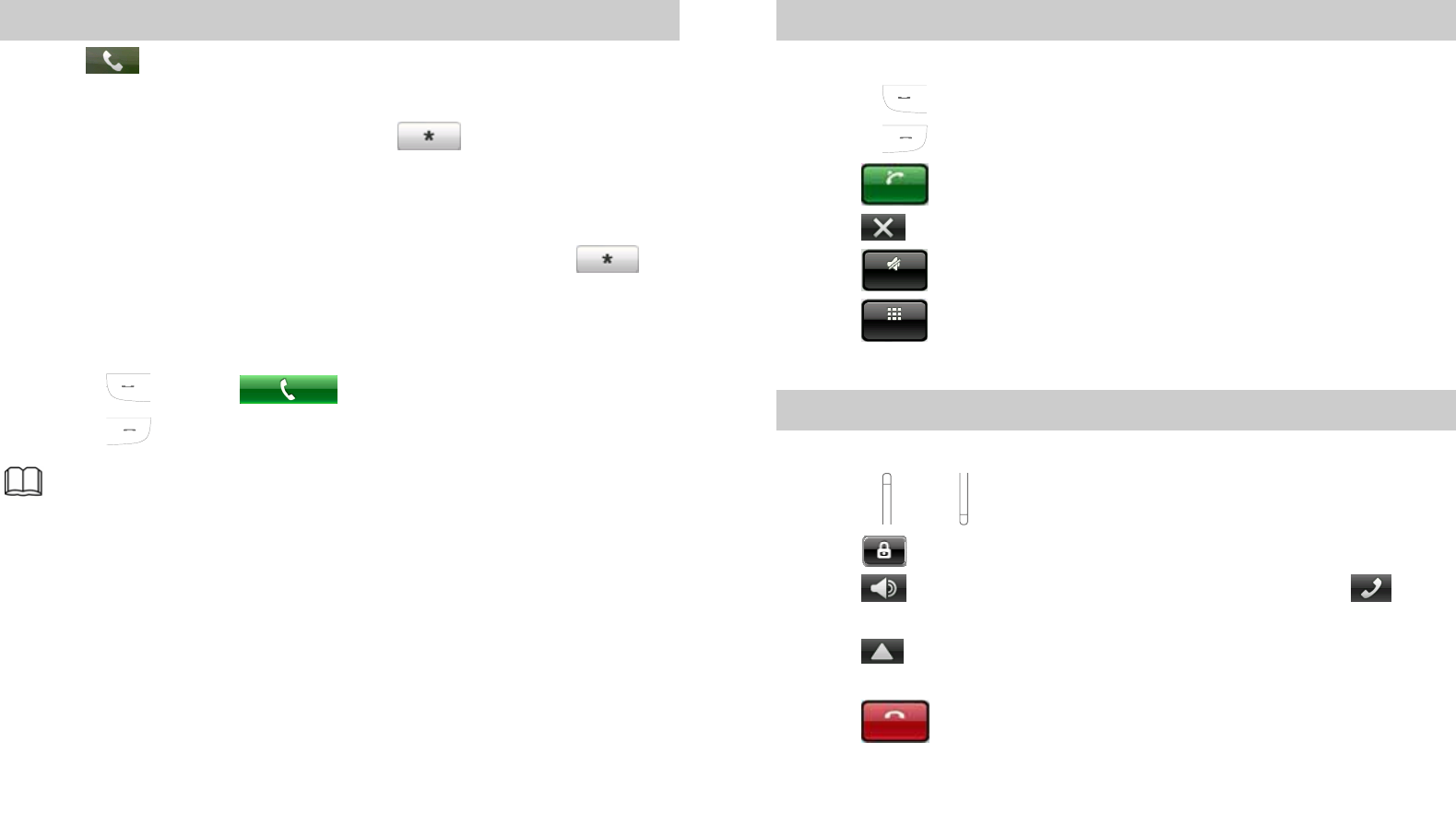
12
Making a Call
1. Tap in standby mode.
2. Enter the phone number.
z To make an international call, tap twice consecutively
to enter the international call prefix (+). Then enter the
country or region code, area code, and phone number in
sequence.
z To call an extension, enter the phone number, tap
three times consecutively to enter P or four times
consecutively to enter W, and then enter the extension
number.
3. Press or tap to dial the number.
4. Press to end the call.
z If you enter P between the phone number and the
extension number, after the phone number is connected,
the phone automatically dials the extension number.
z If you enter W between the phone number and the
extension number, after the phone number is connected,
the phone displays a prompt asking you to choose
whether the extension number needs to be dialed.
z You can also make a call through call logs, contacts, and
messages.
z If your phone supports two SIM cards and if the
dual-SIM mode is enabled, select the SIM card you want
to use according to the prompt displayed on the screen.
13
Answering a Call
When there is an incoming call, you can do as follows:
z Press to answer the call.
z Press to reject the call
z Tap to answer the call.
z Tap to reject the call.
z Tap to mute the ring.
z Tap to enter the phone number or select a contact
from the phonebook to make a new call.
Options During the Call
During a call, you can do as follows:
z Press and to adjust the volume.
z Tap to unlock the screen and the keys.
z Tap to enable the loudspeaker, and then tap to
disable the loudspeaker.
z Tap , and then set Mute to On to mute the call, or Off
to unmute the call.
z Tap to end the call.
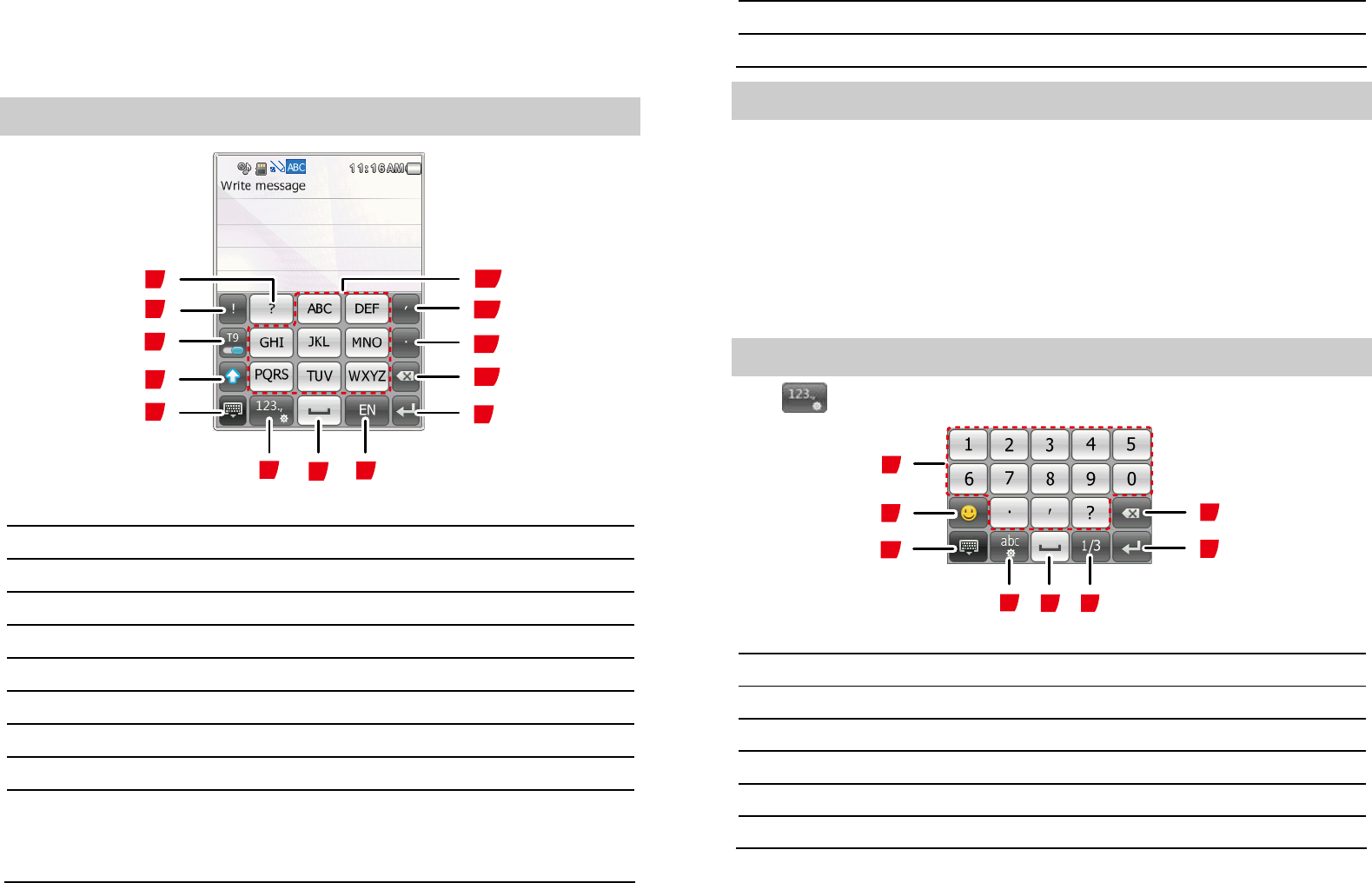
14
4 Text Entry
Text Entry Screen
9
10
11
12
13
2
1
78
4
5
6
3
1 To enter a question mark (?).
2 To enter an exclamatory mark (!).
3 To enable or disable predictive text input mode.
4 To switch between the upper case and the lower case.
5 To close the on-screen keypad.
6 To display the number and symbol panel.
7 To enter a space.
8 To change the text input mode.
9 To enter a newline sign.
10 To clear the character on the left of the cursor.
Tap and hold the key for about three seconds to clear all
the characters.
15
11 To enter a period (.).
12 To enter a comma (,).
13 To enter letters.
Enter Letters
If the T9 mode is enabled, tap each key once according to the
spelling sequence of the desired words. The phone displays all
the commonly used words according to the numeric sequence
of key presses. Tap the desired word to enter it.
If the T9 mode is disabled, tap the key including the desired
letter once to enter the first letter on the key, twice to enter the
second letter on the key, and so on.
Enter Numbers and Symbols
Tap to display the number and symbol panel.
2
1
7
8
456
3
1 To enter numbers, or commonly used punctuations.
2 To display or close the graphics symbols.
3 To close the on-screen keypad.
4 To close the number and symbol panel.
5 To enter a space.
6 To turn pages.
7 To enter a newline sign.

16
8 To clear the character on the left of the cursor. Tap and
hold the key for about three seconds to clear all the
characters.
17
5 Messaging
Tap in standby mode, and then select Messaging >
Write message.
Tap to and recipient(s). You can enter the phone number
or select the recipient from Contacts.
Tap to send the message.
If you want to create a multimedia message, tap to add
pictures, video clips, audio clips, attachments, or text template
and so on.
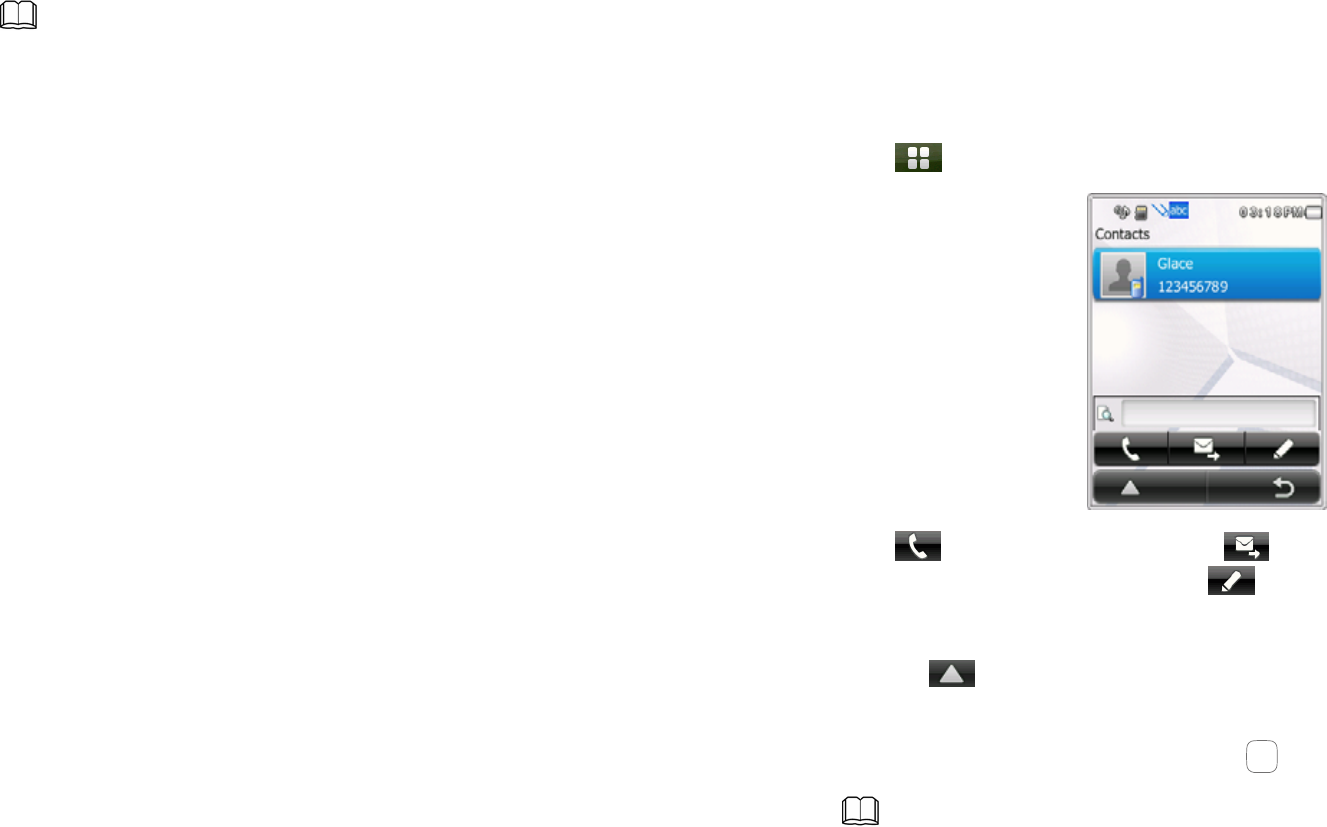
18
z Before creating and sending multimedia messages,
contact your service provider for the availability of the
Multimedia Messaging Service (MMS) and the method of
subscribing to the services.
z Open multimedia messages with caution. Multimedia
messages may contain objects that can damage your
phone, such as malicious software.
z If your phone supports two SIM cards and if the
dual-SIM mode is enabled, select the SIM card you want
to use according to the prompt displayed on the screen.
19
6 Contacts
Tap in standby mode, and then select Contacts.
Tap to call the contact, tap to write and send a
message to the contact, or tap to edit the contact.
Creating a Contact
1. Tap , and then select Add new contact.
2. Edit the contact.
3. After editing the contact, press and then select Done.
If your phone supports two SIM cards and if the dual-SIM
mode is enabled, you may need to select To SIM1 or To
SIM2.
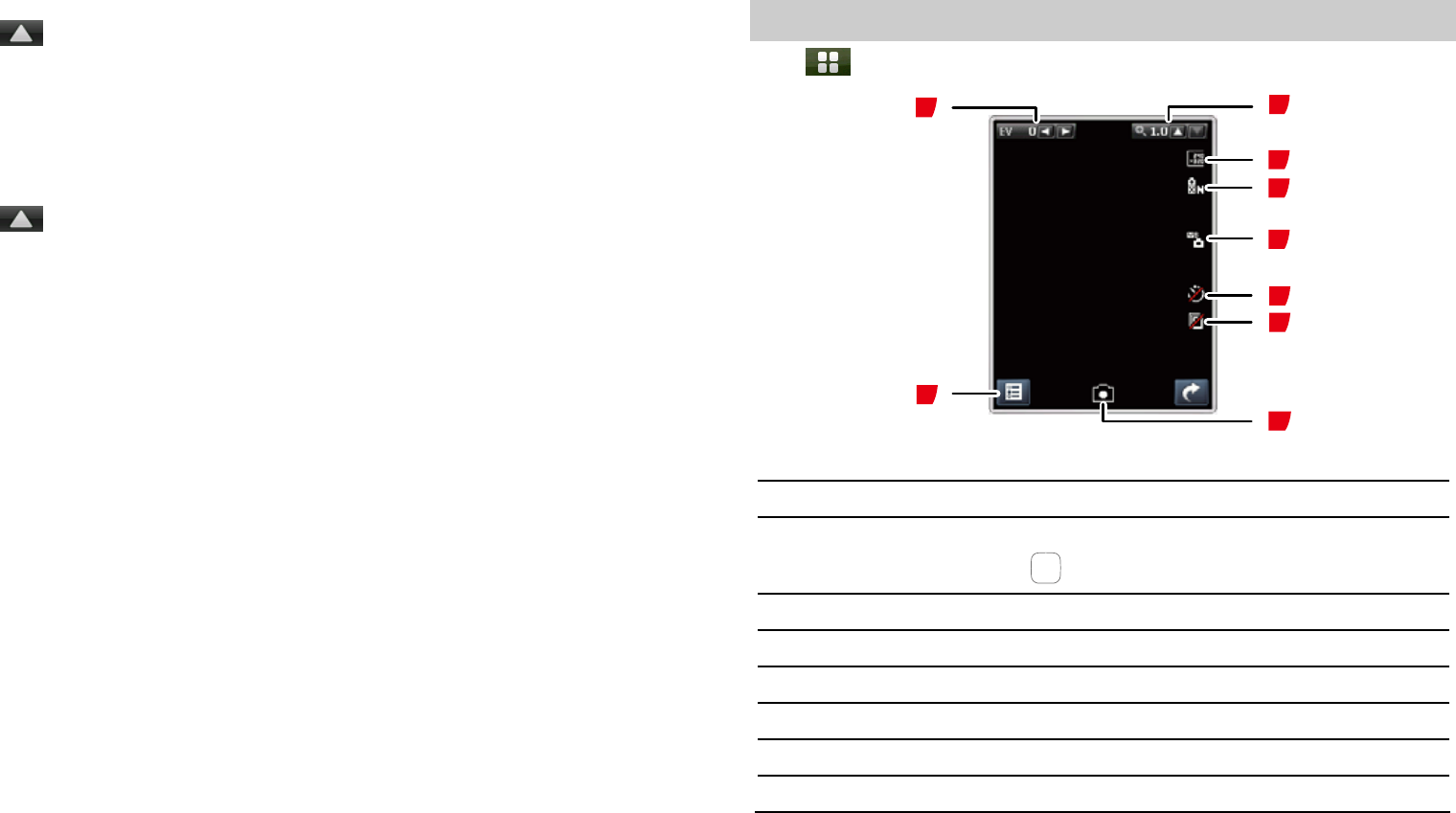
20
Searching for a Contact
Enter the contact name or the first consecutive letters of the
name, and then select the contact from the list.
Setting the Preferred Storage
Tap , and then select Phonebook settings > Preferred
storage to select the storage that you want to use.
Speed dial
Use speed dial to make a call quickly by tapping and holding an
on-screen numeric key for about three seconds.
Tap , and then select Phonebook settings > Speed dial
to set up a speed dial for a phone number.
21
7 Camera
Taking a Picture
Tap in standby mode, and then select Camera.
2
1
4
5
9
7
8
6
3
1 To adjust the brightness.
2 To view photos, or perform camera or photo settings.
3 To take a picture.
You can also press to take pictures.
4 To set continuous shooting.
5 To set the self-timer.
6 To set the white balance.
7 To set the picture quality.
8 To set the picture size.
9 To adjust the focus.
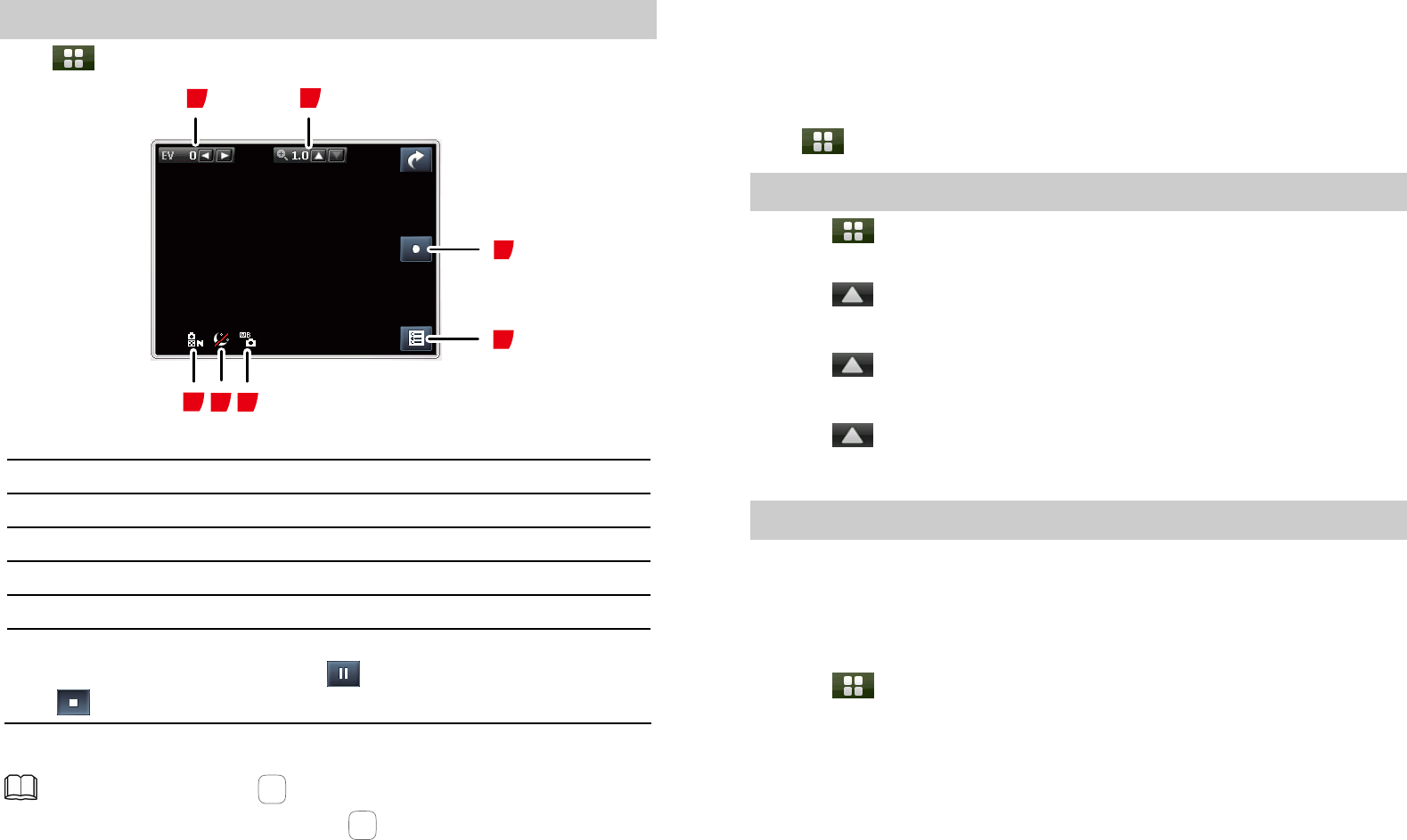
22
Recording a Video Clip
Tap in standby mode, and then select Video camera.
2
1
7
45
6
3
1 To adjust the focus.
2 To adjust the brightness.
3 To set the video quality.
4 To enable or disable the night mode.
5 To set the white balance.
6 To view videos, or perform camera or video settings.
7 To start recording the video clip.
During the recording, tap to pause or continue, tap
to stop the recording and save the video clip.
You can also press to start recording the video clip.
During the recording, press to pause or continue.
23
8 Media Player
Tap in standby mode, and then select Media player.
Creating a New Playlist
1. Tap in standby mode, and then select Media player >
My playlists.
2. Tap , and then select New.
3. Edit the playlist name.
4. Tap , and then select Done.
5. Tap the playlist to display it.
6. Tap , and then select Add.
7. Add video files to the playlist.
Playing a Media File
Select a media file stored in the phone or on the microSD card,
and then tap to play it.
You can also add your favorite media files to some playlist. Then,
select a media file from the playlist, and then play it.
1. Tap in standby mode, and then select Media player >
My playlists.
2. Select a playlist.
3. Tap the playlist to display it.
4. Select a media file.
5. Tap the media file to play it.
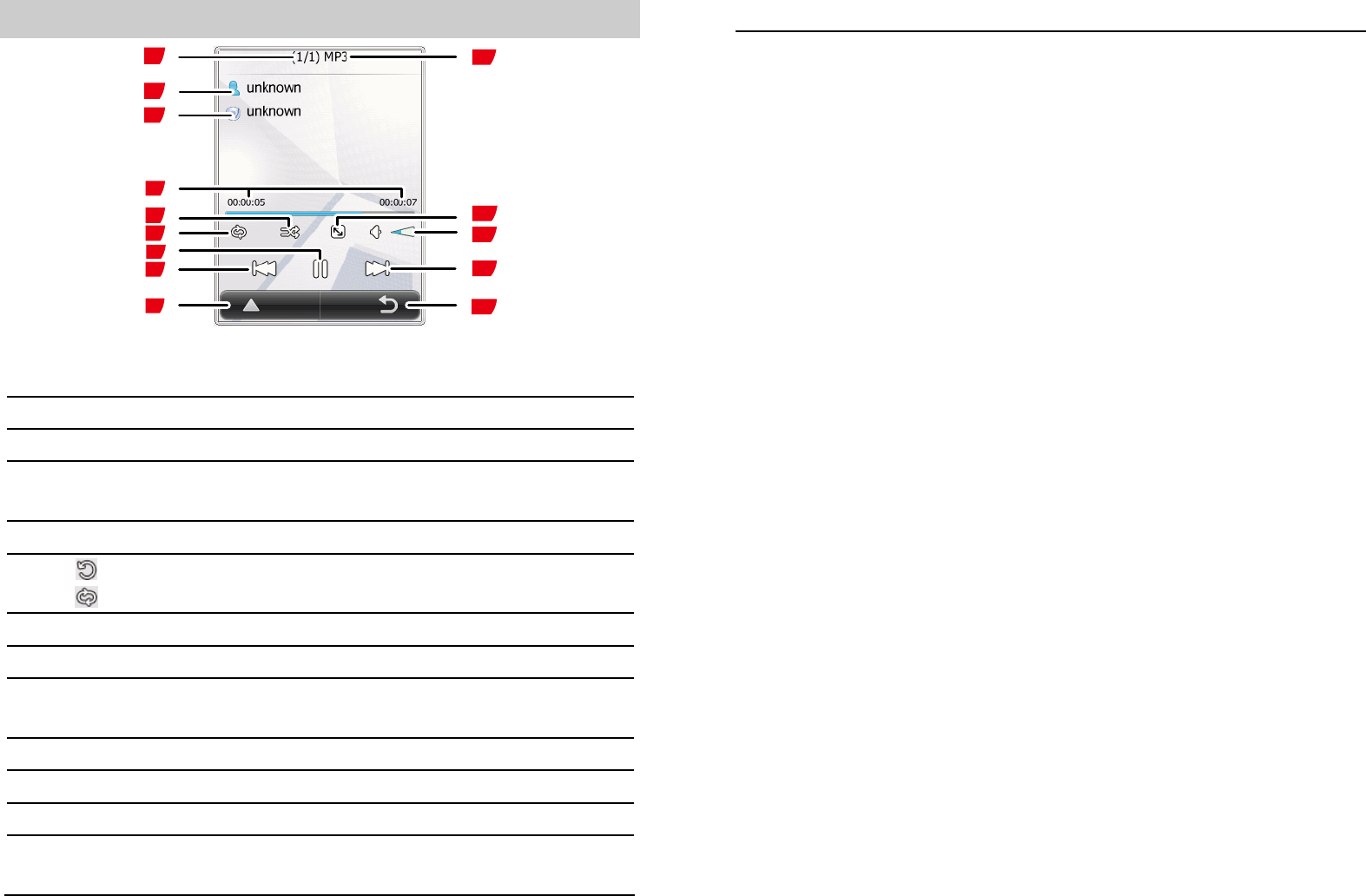
24
Media Player
910
11
12
13
14
2
1
7
8
4
5
6
3
1 To indicate the number of the current media file and total
number of the media files in the playlist.
2 To indicate the artist
3 To indicate the album
4 To indicate the played duration and playing progress of
the current media file.
5 To play media files randomly.
6 z : To play a media file repeatedly.
z : To play media files in the current playlist circularly.
7 To pause or continue.
8 To switch to the previous media file.
9 To display the current playlist, perform settings or view
the details of the current media file.
10 To exit the media player.
11 To switch to the next media file.
12 To indicate the volume.
13 To switch to the full-screen mode. You can also press the
confirm key to switch to or exit the full-screen mode.
25
14 To indicate the name of the current media file.
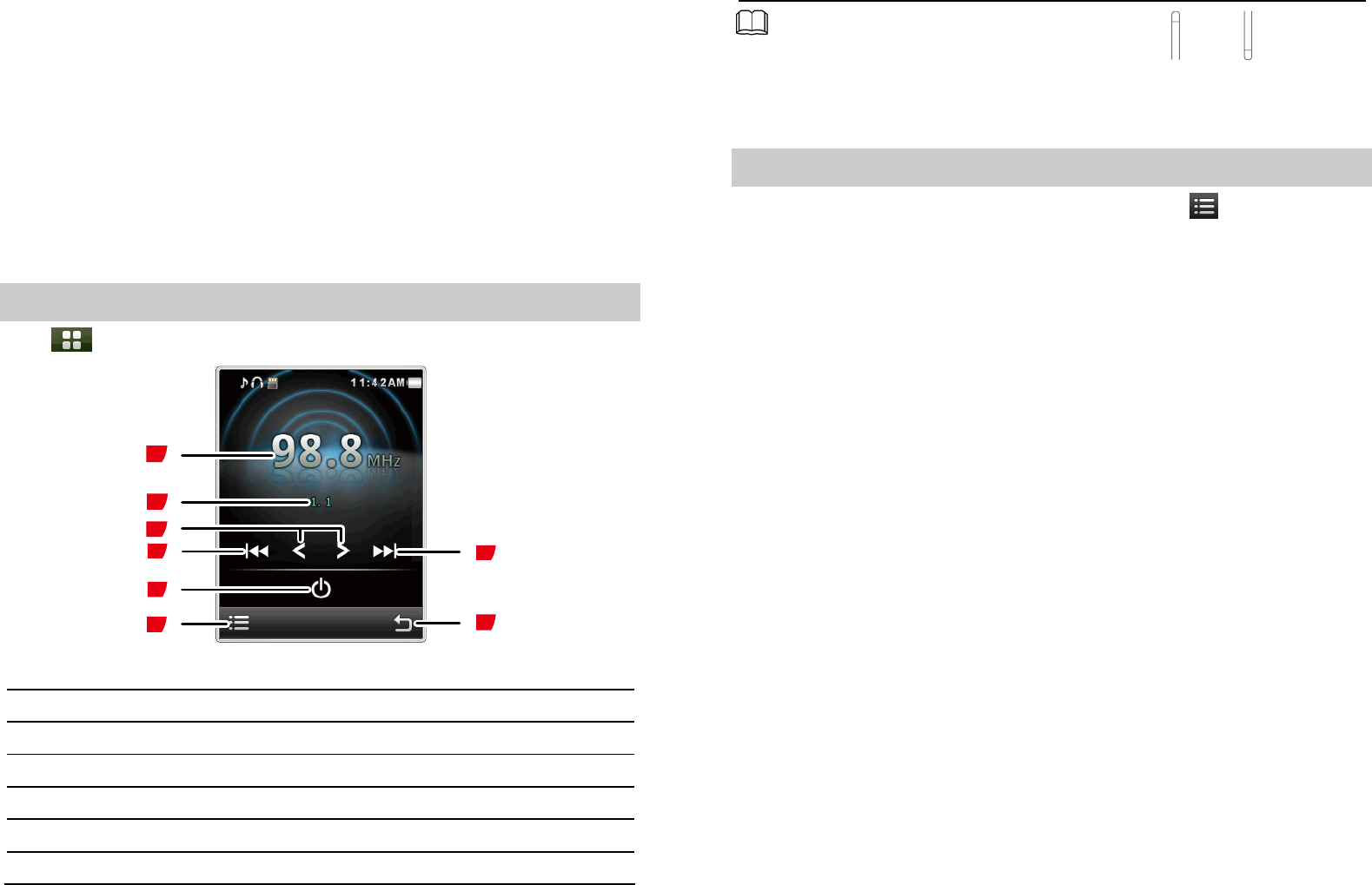
26
9 FM Radio
Before using the FM radio, connect a compatible headset to
your phone.
The headset cable also functions as an antenna. To ensure good
reception of radio programs and superior audio quality, do not
disconnect the headset from your phone or bend the headset
cable with force.
FM Radio
Tap in standby mode, and then select FM radio.
2
1
7
8
4
5
6
3
1 To indicate the frequency of the current program.
2 To indicate the number and name of the current channel.
3 To adjust the frequency by 0.1 MHz.
4 To switch to the previous channel.
5 To switch on or off the FM radio.
6 To view the channel list, tune, or perform settings.
7 To exit the FM radio screen.
27
8 To switch to the next channel.
When listening to the FM radio, press and to adjust
the volume.
Tuning
If there is no channel in the channel list, tap , and then
select from the following options:
z Auto search: to search for channels automatically and save
them to the channel list. The phone can save up to 30
channels.
z Manual input: to enter a frequency and play the programs
on it.
10 WAP
You can access Wireless Application Protocol (WAP) sites and
use WAP-based services on your phone. To access WAP sites on
your phone, you need to subscribe to the corresponding service
from the service provider and set relevant parameters on your
phone.
For details about the service and the charges, contact your
service provider.
If your phone supports two SIM cards and if the double-SIM
mode is enabled, you need to set the account information of
SIM1 and SIM2, and select Menu > WAP > Internet service
> Settings > Select SIM to set the default SIM card when
connecting to the network.

28
Setting the Connection Profile
To access WAP sites on your phone, you need to set your
account information first. The account information is provided
by your service provider.
1. Tap in standby mode, and then select WAP >
Internet service > Settings > Profiles.
2. Select your service provider.
If your service provider is not in the list, tap Add new to add
it.
3. Tap the profile to activate it.
Connecting to the Network
1. Tap in standby mode, and then select WAP >
Internet service.
2. Select one of the following methods to connect to the
network.
z Homepage: to display the homepage.
z Input address: to access the WAP site linked to the address
you specify.
z Last web address: to display the last WAP page that you
accessed.
z Recent pages: to display the recent WAP pages that you
accessed, and then tap one to display it.
29
11 Connectivity
USB
When connected to the PC with the USB data cable, your phone
can be used as a USB flash drive. In this case, you can read and
manage the files stored in the phone memory or on the microSD
card on the computer.
Only Windows 2000, Windows XP, and Windows Vista
operating systems are supported.
Bluetooth
Through Bluetooth, you can transfer data between your phone
and other devices supporting Bluetooth. You can also talk on
the phone and listen to music by using a Bluetooth headset.
Enabling the Bluetooth Function
Before performing the Bluetooth-related settings, do as follows
to enable the Bluetooth function.
Tap in standby mode, select Connectivity > Bluetooth,
and then set Power to On.
Transferring Data
Through Bluetooth, you can transfer data between your phone
and other devices supporting Bluetooth.
1. Enable the Bluetooth function.
2. Select My device > Search new device to search for
other Bluetooth-supported devices within a valid range.
30
3. Tap the required device to pair.
When a device is found for the first time, a password is
required for authentication.
Using a Bluetooth Headset
After a Bluetooth headset is paired with and connected to the
phone, the headset icon is displayed on the standby screen.
Then, you can use the headset for communication.
1. Enable the Bluetooth function.
2. Select Device list > Search audio device.
3. Tap your Bluetooth headset to connect it.
31
12 Warnings and Precautions
This section contains important information pertaining to the
operating instructions of your device. It also contains
information about how to use the device safely. Read this
information carefully before using your device.
Electronic Device
Power off your device if using the device is prohibited. Do not
use the device when using the device causes danger or
interference with electronic devices.
Medical Device
z Follow rules and regulations set forth by hospitals and health
care facilities. Do not use your device when using the device
is prohibited.
z Pacemaker manufacturers recommend that a minimum
distance of 15 cm be maintained between a device and a
pacemaker to prevent potential interference with the
pacemaker. If you are using a pacemaker, use the device on
the opposite side of the pacemaker and do not carry the
device in your front pocket.
Potentially Explosive Atmosphere
Power off your device in any area with a potentially explosive
atmosphere, and comply with all signs and instructions. Areas
that may have potentially explosive atmospheres include the
areas where you would normally be advised to turn off your
vehicle engine. Triggering of sparks in such areas could cause
an explosion or a fire, resulting in bodily injuries or even deaths.
Do not power on your device at refueling points such as service
32
stations. Comply with restrictions on the use of radio equipment
in fuel depots, storage, and distribution areas, and chemical
plants. In addition, adhere to restrictions in areas where
blasting operations are in progress. Before using the device,
watch out for areas that have potentially explosive atmospheres
that are often, but not always, clearly marked. Such locations
include areas below the deck on boats, chemical transfer or
storage facilities, and areas where the air contains chemicals or
particles such as grain, dust, or metal powders. Ask the
manufacturers of vehicles using liquefied petroleum gas (such
as propane or butane) whether this device can be safely used in
their vicinity.
Traffic Security
Observe local laws and regulations while using the device. In
addition, if using the device while driving a vehicle, comply with
the following guidelines:
z Concentrate on driving. Your first responsibility is to drive
safely.
z Do not talk on the device while driving. Use hands-free
accessories.
z When you have to make or answer a call, park the vehicle at
the road side before using your device.
z RF signals may affect electronic systems of motor vehicles.
For more information, consult the vehicle manufacturer.
z In a motor vehicle, do not place the device over the air bag
or in the air bag deployment area. Otherwise, the device may
hurt you owing to the strong force when the air bag inflates.
z Do not use your device while flying in an aircraft. Power off
your device before boarding an aircraft. Using wireless
devices in an aircraft may cause danger to the operation of
33
the aircraft and disrupt the wireless telephone network. It
may also be considered illegal.
Operating Environment
z Do not use or charge the device in dusty, damp, and dirty
places or places with magnetic fields. Otherwise, it may
result in a malfunction of the circuit.
z The device complies with the RF specifications when the
device is used near your ear or at a distance of 1.5 cm from
your body. Ensure that the device accessories such as a
device case and a device holster are not composed of metal
components. Keep your device 1.5 cm away from your body
to meet the requirement earlier mentioned.
z On a stormy day with thunder, do not use your device when
it is being charged, to prevent any danger caused by
lightning.
z When you are on a call, do not touch the antenna. Touching
the antenna affects the call quality and results in increase in
power consumption. As a result, the talk time and the
standby time are reduced.
z While using the device, observe the local laws and
regulations, and respect others' privacy and legal rights.
z Keep the ambient temperature between 0°C and 45°C while
the device is being charged. Keep the ambient temperature
between –10°C to 55°C for using the device powered by a
battery.
Prevention of Hearing Damage
Using a headset at high volume can damage your hearing. To
reduce the risk of damage to hearing, lower the headset volume
to a safe and comfortable level.
34
Safety of Children
Comply with all precautions with regard to children's safety.
Letting the child play with your device or its accessories, which
may include parts that can be detached from the device, may be
dangerous, as it may present a choking hazard. Ensure that
small children are kept away from the device and accessories.
Accessories
Use the accessories delivered only by the manufacturer. Using
accessories of other manufacturers or vendors with this device
model may invalidate any approval or warranty applicable to the
device, result in the non-operation of the device, and cause
danger.
Battery and Charger
z Unplug the charger from the electrical plug and the device
when not in use.
z The battery can be charged and discharged hundreds of
times before it eventually wears out. When the standby time
and the talk time are shorter than the normal time, replace
the battery.
z Use the AC power supply defined in the specifications of the
charger. An improper power voltage may cause a fire or a
malfunction of the charger.
z Do not connect two poles of the battery with conductors,
such as metal materials, keys, or jewelries. Otherwise, the
battery may be short-circuited and may cause injuries and
burns on your body.
z Do not disassemble the battery or solder the battery poles.
Otherwise, it may lead to electrolyte leakage, overheating,
fire, or explosion.
35
z If battery electrolyte leaks out, ensure that the electrolyte
does not touch your skin and eyes. When the electrolyte
touches your skin or splashes into your eyes, wash your eyes
with clean water immediately and consult a doctor.
z If there is a case of battery deformation, color change, or
abnormal heating while you charge or store the battery,
remove the battery immediately and stop using it. Otherwise,
it may lead to battery leakage, overheating, explosion, or
fire.
z If the power cable is damaged (for example, the cord is
exposed or broken), or the plug loosens, stop using the cable
at once. Otherwise, it may lead to an electric shock, a short
circuit of the charger, or a fire.
z Do not dispose of batteries in fire as they may explode.
Batteries may also explode if damaged.
Cleaning and Maintenance
z The device, battery, and charger are not water-resistant.
Keep them dry. Protect the device, battery, and charger from
water or vapor. Do not touch the device or the charger with a
wet hand. Otherwise, it may lead to a short circuit, a
malfunction of the device, and an electric shock to the user.
z Do not place your device, battery, and charger in places
where they can get damaged because of collision. Otherwise,
it may lead to battery leakage, device malfunction,
overheating, fire, or explosion.
z Do not place magnetic storage media such as magnetic cards
and floppy disks near the device. Radiation from the device
may erase the information stored on them.
z Do not leave your device, battery, and charger in a place with
an extreme high or low temperature. Otherwise, they may
not function properly and may lead to a fire or an explosion.
36
When the temperature is lower than 0°C, performance of the
battery is affected.
z Do not place sharp metal objects such as pins near the
earpiece. The earpiece may attract these objects and hurt
you when you are using the device.
z Before you clean or maintain the device, power off the device
and disconnect it from the charger.
z Do not use any chemical detergent, powder, or other
chemical agents (such as alcohol and benzene) to clean the
device and the charger. Otherwise, parts of the device may
be damaged or a fire can be caused. You can clean the
device and the charger with a piece of damp and soft
antistatic cloth.
z Do not dismantle the device or accessories. Otherwise, the
warranty on the device and accessories is invalid and the
manufacturer is not liable to pay for the damage.
Emergency Call
You can use your device for emergency calls in the service area.
The connection, however, cannot be guaranteed in all
conditions. You should not rely solely on the device for essential
communications.
Certification Information (SAR)
This mobile device meets guidelines for exposure to radio
waves.
Your device is a low-power radio transmitter and receiver. As
recommended by international guidelines, the mobile device is
designed not to exceed the limits for exposure to radio waves.
These guidelines were developed by the independent scientific
organization International Commission on Non-Ionizing
Radiation Protection (ICNIRP) and include safety measures
37
designed to ensure safety for all users, regardless of age and
health.
The Specific Absorption Rate (SAR) is the unit of measurement
for the amount of radio frequency energy absorbed by the body
when using a device. The SAR value is determined at the
highest certified power level in laboratory conditions, but the
actual SAR level of the device when being operated can be well
below the value. This is because the device is designed to use
the minimum power required to reach the network.
The SAR limit also adopted by Europe is 2.0 W/kg averaged over
10 grams of tissue. The highest SAR value for this device type
when tested at the ear is 0.85 W/kg, and when properly worn
on the body is 0.749 W/kg.
The tests are performed in positions and locations (that is, at
the ear and worn on the body) as required by the FCC for each
model. For body worn operation, this phone has been tested
and meets FCC RF exposure guidelines when the handset is
positioned a minimum of 15 mm from the body with an
accessory that contains no metal part. Use of other accessories
may not ensure compliance with FCC RF exposure guidelines.
The SAR limit adopted by USA and Canada is 1.6 watts/kilogram
(W/kg) averaged over one gram of tissue. The highest SAR
value reported to the FCC and IC for this device type when
tested at the ear is 0.742 W/kg, and when properly worn on the
body is 0.787 W/kg.
FCC Statement
This equipment has been tested and found to comply with the
limits for a Class B digital device, pursuant to Part 15 of the FCC
Rules. These limits are designed to provide reasonable
protection against harmful interference in a residential
installation. This equipment generates, uses and can radiate

38
radio frequency energy and, if not installed and used in
accordance with the instructions, may cause harmful
interference to radio communications. However,there is no
guarantee that interference will not occur in a particular
installation.If this equipment does cause harmful interference to
radio or television reception,which can be determined by
turning the equipment off and on, the user is encouraged to try
to correct the interference by one or more of the following
measures:
z Reorient or relocate the receiving antenna.
z Increase the separation between the equipment and
receiver.
z Connect the equipment into an outlet on a circuit different
from that to which the receiver is connected.
z Consult the dealer or an experienced radio/TV technician for
help.
This device complies with Part 15 of the FCC Rules. Operation is
subject to the following two conditions: (1) This device may not
cause harmful interference, and (2) his device must accept any
interference received, including interference that may cause
undesired operation.
Warning: Changes or modifications made to this device not
expressly approved by Huawei Technologies Co., Ltd. may void
the FCC authorization to operate this device.
39
Disposal and Recycling Information
This symbol on the device (and any included batteries)
indicates that they should not be disposed of as normal
household garbage. Do not dispose of your device or
batteries as unsorted municipal waste. The device (and
any batteries) should be handed over to a certified
collection point for recycling or proper disposal at the
end of their life.
For more detailed information about the recycling of the device
or batteries, contact your local city office, the household waste
disposal service, or the retail store where you purchased this
device.
The disposal of this device is subject to the Waste from
Electrical and Electronic Equipment (WEEE) directive of the
European Union. The reason for separating WEEE and batteries
from other waste is to minimize the potential environmental
impacts on human health of any hazardous substances that
may be present.
Reduction of Hazardous Substances
This device is compliant with the EU Registration, Evaluation,
Authorisation and Restriction of Chemicals (REACH) Regulation
(Regulation No 1907/2006/EC of the European Parliament and
of the Council) and the EU Restriction of Hazardous Substances
(RoHS) Directive (Directive 2002/95/EC of the European
Parliament and of the Council). For more information about the
REACH compliance of the device, visit the Web site
www.huaweidevice.com/certification. You are recommended to
visit the Web site regularly for up-to-date information.

40
EU Regulatory Conformance
Hereby, Huawei Technologies Co., Ltd. declares that this device
is in compliance with the essential requirements and other
relevant provisions of Directive 1999/5/EC.
For the declaration of conformity, visit the Web site
www.huaweidevice.com/certification.
Notice: Observe the national local regulations in the location
where the device is to be used. This device may be restricted for
use in some or all countries of European Union.
Version: V100R001_01 NO.: 6015XXX